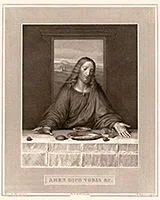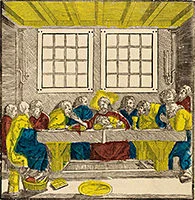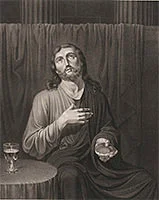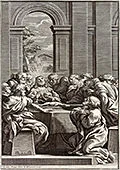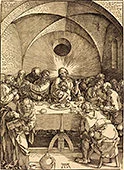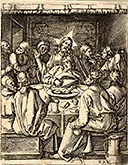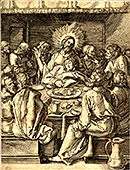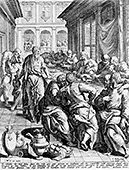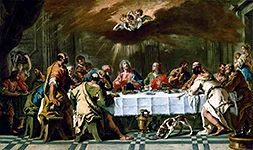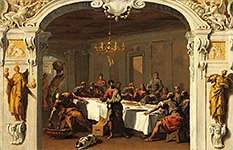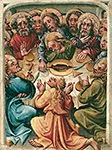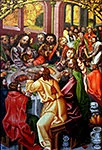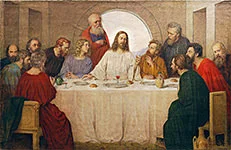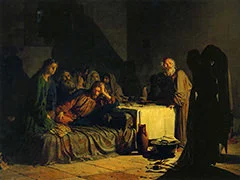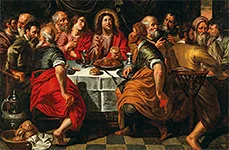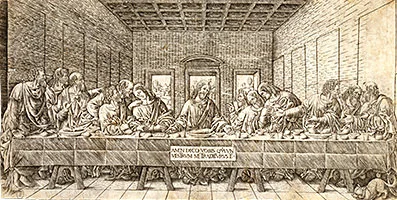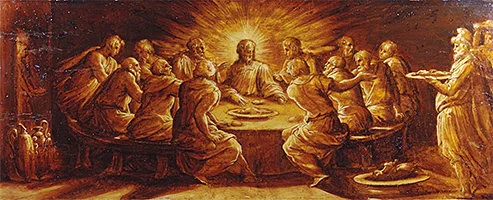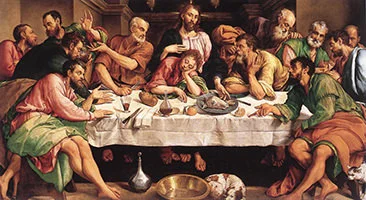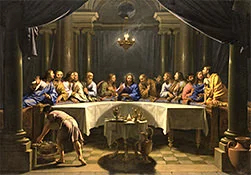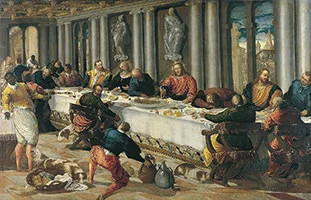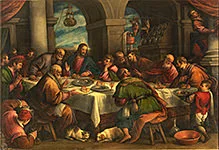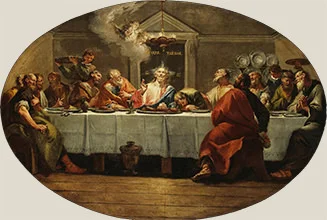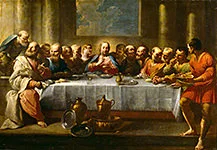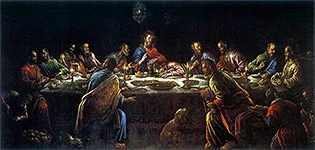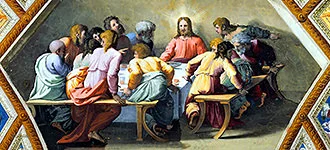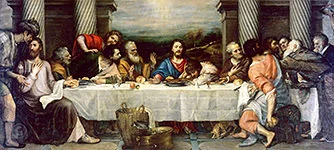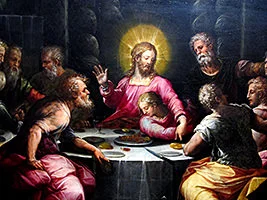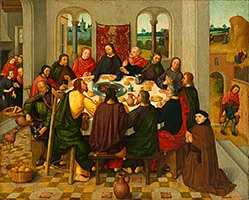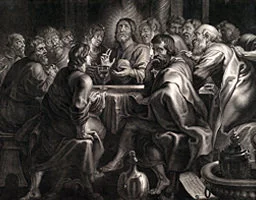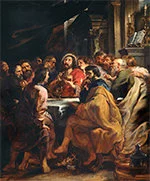The Art World Commemorates Peter
— Album 11 of 17 Photo Albums —
Warren Camp’s presentation of 550 famous “Peter” works of art includes historic paintings, frescoes, stained glass, etchings, sculptures, engravings, and other artwork monuments. They come from the Gothic (1100–1400), High Renaissance, Baroque, Rococo, Neoclassical, and Romantic (1800s) eras.
All are popular works, designed and created by celebrated artists, many of whom you’ll likely recognize, including Rembrandt, Raphael, Michelangelo, El Greco, Da Vinci, Masaccio, Huret, Galle, Tissot, Botticelli, Dürer, Rubens, and many more. They’ll bring back recollections of your “Art History 101” classes, using Janson’s History of Art textbook.
Whether depicting “Cephas,” “Petrus,” “Simon,” “Simeon,” “Simon Bar-Jonah,” “Simon Peter,” “The Rock,” “Peter,” “Apostle Peter,” or “Saint Peter,” the enlarged images of this acclaimed Bible figure come with factual and enlightening details: the artist’s bio; when each work was created; where it can be seen; applicable Bible passages; background and highlights of each work; and photo sources with copyright notices.
To appreciate the impact that Peter had on numerous art-world masters, be sure to click each thumbnail to enlarge it.
• These photo albums complement the Bible-study commentaries Warren has written for “1st and 2nd Peter,” found here.
…
Album 1 (Peter, alone) | Album 2 | Album 3 | Album 4 | Album 5
Album 6 | Album 7 | Album 8 | Album 9 | Album 10 | Album 11
Album 12 | Album 13 | Album 14 | Album 15 | Album 16 | Album 17
Album topics are shown at the [ ⇓ bottom ⇓ ] of each page.
Jesus’ Last Supper — Part 3 of 4
136 “Last Supper” Masterpieces in Four Photo Albums
Includes Dürer, Bassano, Ricci, Titian, Vasari, Allori, Raphael, Fontebasso, Raimondi, Caspari, and more
with His Disciples”
Slide 2
Click to enlarge.
Johannes Egbertus van Lieshout
1773 woodcut
Slide 9 — Click to enlarge and read its detailed caption.
“La Última Cena” painting by Alessandro Allori, 1582, oil on canvas
Slide 21
Click to enlarge.
Giovanni Pietro da Birago, c. 1500 engraving
See more “Last Supper” masterpieces in Warren Camp’s Album 12.
- 1. “Christ at the Last Supper,” steel engraving on paper, by Friedrich Wagner, c. 1840, after Leonardo da Vinci
This detail of Friedrich Wagner’s steel-on-paper engraving of Christ at the Last Supper (a copy of a section of an engraving by Raphael Morghen shown in the final slide of this album) places Christ alone at the dinner table without his disciples. Although the platter for the Passover lamb hasn’t yet been filled, we see bread and one wine cup atop a clean white tablecloth. The three credits in the footer document the following: this artist’s name at the right; the publisher’s name in the center; and the name of the painter from whom this engraving was designed: Leonardo da Vinci. [See the similarity in both artists’ renderings of Christ Jesus by viewing Leonardo’s enlargement on Album 12, slide 7].
In this framed detail of Christ, designed after Leonardo’s Last Supper, Wagner highlights a bordered header beneath his image of Jesus. In English, the uppercase Latin reads: “Amen I Say to You.” And, in Wagner’s full-size engraving, shown here, it’s easy to see its resemblance to Leonardo’s Last Supper fresco painting. See many more Last Supper engravings.
The Last Supper was the final meal that Jesus shared with his apostles in Jerusalem before his crucifixion. Read the earliest known mention of the Last Supper: For I received from the Lord what I also passed on to you: The Lord Jesus, on the night he was betrayed, took bread, and when he had given thanks, he broke it and said, “This is my body, which is for you; do this in remembrance of me.” In the same way, after supper he took the cup, saying, “This cup is the new covenant in my blood; do this, whenever you drink it, in remembrance of me.” For whenever you eat this bread and drink this cup, you proclaim the Lord’s death until he comes (1 Cor. 11:23–26 NIV).
… Height: 16.9 in. (428 mm), width: 13.4 in. (340 mm)
… Photo source, license, attribution, museum details, and image enlargement: Rijksmuseum Amsterdam
Return to “Peter Masterpieces” album’s opening page or to the top of this page or open the next album. - 2. “Last Conversations of Jesus Christ with His Disciples,” woodcut with letterpress text by Johannes van Lieshout, 1773
The letterpress text beneath this colorful woodcut by Johannes Egbertus van Lieshout starts with the title in Dutch, Laetste gesprekken van Jezus Christs met zyne leerlingen. It translates as Last Conversations of Jesus Christ with His Disciples. Beneath that title are two relevant captions in Dutch. The left caption, a lead-in to the gospel passage cited in the right caption, is roughly translated: “The disciples sat in mournful silence around Jesus. The approaching farewell from their divine Friend and Master would be dear to their hearts. Jesus kindly turned to them and poured out his heart again before them. The words that He spoke were so full of divine wisdom and love that you will not read them without feeling inner distress.” The right half’s passage is John 14:1–4.
Within this blue, yellow, and red woodcut, Christ with his halo is centered at the dinner table with his twelve disciples. On it is only one loaf of bread and one wine goblet. Young John seems to be sleeping on the table, based on interpretations by Van Lieshout and other artists of the actual text of John 13:23 NIV: “One of them, the disciple whom Jesus loved, was reclining next to him.”
Herein, the artist also follows the biblical text of John 13:26, showing Jesus giving a piece of dipped bread directly to Judas Iscariot (left-center in yellow). Warren Camp has compiled this list of twenty-one sequential events leading up to and following the Last Supper. Each event, such as “Jesus Washes His Disciples’ Feet,” “Judas Identified as the Betrayer,” and “Departing the Upper Room,” is presented in the order in which it occurred.
… Height: 15.6 in. (396 mm), width: 12.9 in. (327 mm)
… Photo source, license, attribution, museum details, and image enlargement: Rijksmuseum Amsterdam; gift of F. G. Waller, Amsterdam
… The artist’s biography could not be found; here are his other works of art
Return to “Peter Masterpieces” album’s opening page or to the top of this page or open the next album. - 3. “Christ at the Last Supper,” etching proof by Jan Willem Caspari, 1808–1822, after C Forssell
In this proof by Jan Willem Caspari, a stipple-work etching of Christ at the Last Supper, the artist has Christ sitting alone at a small, round table. His left hand holds a small loaf of bread while his right hand rests on his chest. According to the New Testament’s gospel accounts, Christ broke bread at his Last Supper and said, “Take and eat; this is my body” (Matthew 26:26). Next to him on the table is a wine chalice.
The title beneath the etching — left half in Latin, right half in Dutch — reads “Christ at the Lord’s Supper.” Beneath the title, the Latin and Dutch text reads “Drawn by” and “Engraved by.” Beneath “Amsterdam” is the publisher’s name.
“The Last Supper was a significant event that proclaimed a turning point in God’s plan for the world. In comparing the crucifixion of Jesus to the feast of Passover, we can readily see the redemptive nature of Christ’s death. As symbolized by the original Passover sacrifice in the Old Testament, Christ’s death atones for the sins of His people; His blood rescues us from death and saves us from slavery. Today, the Lord’s Supper is when believers reflect upon Christ’s perfect sacrifice and know that, through our faith in receiving Him, we will be with Him forever (Luke 22:18; Revelation 3:20).”[1]
See hundreds more Last Supper artwork varieties from Rijksmuseum Amsterdam in addition to its numerous Last Supper engraved prints.
… Height: 19.6 in. (499 mm), width: 15.1 in. (383 mm)
… Photo source, license, attribution, museum details, and image enlargement: Rijksmuseum Amsterdam; gift of C. P. D. Pape
… The artist’s biography could not be found; here are his other works of art
Return to “Peter Masterpieces” album’s opening page or to the top of this page or open the next album. - 4. “The Last Supper, Christ and His Apostles, Seated at a Table” engraving by Cornelis Bloemaert, 1662, after Ciro Ferri
This is Cornelis Bloemaert’s “The Last Supper, Christ and His Apostles, Seated at a Table.” His engraving depicts the interior of a classical building that has Christ and his apostles seated at a table. Jesus holds a bread loaf while raising his right hand and looking upwards in a blessing. Judas Iscariot, sitting on a stool (front-left), conceals his bag of coins behind him while placing his left hand on the dinner table, readying himself to rise and leave.
Who was Judas Iscariot? “Typically remembered for one thing, his betrayal of Jesus, Judas was one of twelve disciples who lived with and followed Jesus for three years, witnessing Jesus’ ministry, teaching, and many miracles. Being the group treasurer, he used this trusted position to steal from their resources (John 12:6). Money was important to Judas. As a thief, according to Matthew 26:14–15, the chief priests paid him “thirty pieces of silver” to betray the Lord. Given his close proximity to Jesus during three years of ministry, it’s hard to imagine how he could follow through on such a dastardly betrayal.” Note the concern, worry, or suspicion on every apostles’s face. Jesus had just told everyone at the table, “Truly, I say to you, one of you will betray me” (Matthew 26:21 ESV). Given his close proximity to Jesus during three years of ministry, it’s hard to imagine how he could follow through on such a dastardly betrayal.”[1]
See hundreds more Last Supper artwork varieties from Rijksmuseum Amsterdam in addition to its numerous Last Supper engraved prints.
… Height: 12 3/8 in. (31.4 cm), width: 7 11/16 in. (19.5 cm)
… Photo source, license, attribution, museum details, and image enlargement: The Met; the Elisha Whittelsey Collection, the Elisha Whittelsey Fund, 1951
… The artist’s short biography; his other works of art
Return to “Peter Masterpieces” album’s opening page or to the top of this page or open the next album. - 5. “The Last Supper,” woodcut print on paper, by Albrecht Dürer, 1510
Albrecht Dürer (1471–1528, Nuremburg), undisputed master of the woodcut, is one of the most celebrated Northern Renaissance painters and printmakers. His etchings, engravings, and woodcut prints contain exquisite detail and elaborate imagery that draw on religious and philosophical ideas.
“In this spectacular work, Dürer creates a fascinating rendition of The Last Supper, belonging to The Large Passion series of twelve woodcuts. Each character and disciple is meticulously detailed, showing vibrant movement and expressions, full of thought and contemplation. Adding to the piece’s magnificence are skillful plays on optical illusion. According to W L Strauss, ‘The artist has overcome the problem of the narrow, vertical format in a novel manner. While taking liberty with the perspective, the vaulted ceiling, trimmed off on the sides, serves to create an optical illusion, widening the chamber… Dürer has purposely arranged the grouping in a manner as to allow an unobstructed view of the center figure.’”[1]
Dürer presents Christ about to tell his disciples that one of his Twelve will betray him. Judas Iscariot, the betrayer, sits opposite Christ, crouching on a stool, concealing his bag of coins behind his left arm. Centered Christ is about to direct the other disciples to continue in their faith, after his crucifixion. He’ll also tell them that they’ll eventually be recognized for their love for one another (John 13:34–35). This video highlights key features about Dürer and this work.
… Height: 15 9/16 in. (39.6 cm), width: 11 5/16 in. (28.8 cm)
… Photo source, license, attribution, museum details, and image enlargement: The Met; gift of Henry Walters, 1917
… The artist’s short biography; his other works of art; Dürer’s collection of thirty-six “Small Passion” woodcuts and twelve “Large Passion” woodcuts
Return to “Peter Masterpieces” album’s opening page or to the top of this page or open the next album. - 6. “The Last Supper,” engraved print, by Marcantonio Raimondi, 1500–1534, after Albrecht Dürer
This small engraving titled The Last Supper, with Christ Sitting in the Center Embracing John (from the Small Passion of Christ series), followed the undated Albrecht Dürer engraving shown in our next slide. Marcantonio Raimondi, a prolific engraver who published more than 300 prints, lived in Bologna, Italy, at the time that both Dürer and Michelangelo were working there in the early 1510s. He often copied their styles to improve his own work, as was common practice among artists at the time.
Who was Judas Iscariot? “Typically remembered for one thing, his betrayal of Jesus, Judas was one of twelve disciples who lived with and followed Jesus for three years, witnessing Jesus’ ministry, teaching, and many miracles. Being the group treasurer, he used this trusted position to steal from their resources (John 12:6). Money was important to Judas. As a thief, according to Matthew 26:14–15, the chief priests paid him “thirty pieces of silver” to betray the Lord. Given his close proximity to Jesus during three years of ministry, it’s hard to imagine how he could follow through on such a dastardly betrayal.” Note the concern, worry, or suspicion on every apostles’s face. Jesus had just told everyone at the table, “Truly, I say to you, one of you will betray me” (Matthew 26:21 ESV). Given his close proximity to Jesus during three years of ministry, it’s hard to imagine how he could follow through on such a dastardly betrayal.”[1]
… Height: 5 1/16 in. (12.8 cm), width: 4 1/16 in. (10.3 cm)
… Photo source, license, attribution, museum details, and image enlargement: The Met; gift of Henry Walters, 1917
… The artist’s short biography; his other works of art
Return to “Peter Masterpieces” album’s opening page or to the top of this page or open the next album. - 7. “The Last Supper, from the Small Passion” engraving by Albrecht Dürer, undated
Nuremburg artist Albrecht Dürer was accomplished in oil paintings, watercolors, woodcuts, and pen-and-ink drawings; but he’s best known for his engravings. He’d already produced many quality woodcut prints of religious scenes when he began to produce engravings in 1494, after a trip to Italy. This small Last Supper engraving copy from his Small Passion series depicts, in a room apparently lit by Jesus’ glory, the last meal that he’d eaten with his disciples before his arrest and crucifixion. We draw our attention first to Jesus, embracing young John in front of the Passover lamb that the artist had set on a platter. Herein, Jesus looks directly at Judas who sits in the foreground, concealing in his left hand his purse that he held beneath the round table.
Dürer created hundreds of woodcuts. This Kahn Academy video highlights Dürer’s quality of technique in his woodcuts and engravings. “Most of his pieces have a sacred touch. Overall, a majority are religiously themed. Works such as the Last Supper, the Virgin in Glory, and Apocalypse are good examples of Albrecht’s biblical message.”[1] Compare his woodcuts that are in his Large Passion and Small Passion series.
“The Last Supper was a significant event that proclaimed a turning point in God’s plan for the world. Comparing Jesus’ crucifixion to the Passover feast, we can readily see the redemptive nature of Christ’s death. It atones for His people’s sins; His blood rescues us from death and saves us from slavery. Today, the Lord’s Supper is when believers reflect upon Christ’s perfect sacrifice and know that we’ll be with Him forever (Luke 22:18; Revelation 3:20).”[2]
… Height: 4 15/16 in. (12.6 cm), width: 3 3/4 in. (9.6 cm)
… Photo source, license, attribution, museum details, and image enlargement: The Met; Harris Brisbane Dick Fund, 1917
… The artist’s short biography; his other works of art; Dürer’s collection of thirty-six “Small Passion” woodcuts and twelve “Large Passion” woodcuts
Return to “Peter Masterpieces” album’s opening page or to the top of this page or open the next album. - 8. “The Last Supper from the Passion of Christ,” engraving by Johann Sadeler I, 1582, after Maerten de Vos
In his Last Supper from the Passion of Christ 1582 engraving, Johann Saderle I presents Christ and his disciples sitting untraditionally outdoors at a table. Haloed Christ (right-center) embraces young John with his left arm while offering Judas Iscariot (standing, left-center) a piece of bread. With bread, wine, and the Passover lamb set on the table, the engraver follows the biblical text of John 13:26, which reveals that Jesus had given a piece of dipped bread directly to Judas who carries in his right hand a coin purse symbolizing his reward for betraying Jesus. The footer text, in Latin, is a compilation of Scriptures from Matthew 26:17–30 and John 13:18–30. Note: See hundreds more Last Supper artwork varieties; find numerous Last Supper engraved prints.
Find out more about Judas Iscariot “Typically remembered for one thing, his betrayal of Jesus, Judas was one of twelve disciples who lived with and followed Jesus for three years, witnessing Jesus’ ministry, teaching, and many miracles. Being the group treasurer, he used this trusted position to steal from their resources (John 12:6). Money was important to Judas. As a thief, according to Matthew 26:14–15, the chief priests paid him “thirty pieces of silver” to betray the Lord. Given his close proximity to Jesus during three years of ministry, it’s hard to imagine how he could follow through on such a dastardly betrayal.” Note the concern, worry, or suspicion on every apostles’s face. Jesus had just told everyone at the table, “Truly, I say to you, one of you will betray me” (Matthew 26:21 ESV). Given his close proximity to Jesus during three years of ministry, it’s hard to imagine how he could follow through on such a dastardly betrayal.”[1]
… Height: 9 7/16 in. (23.9 cm), width: 7 7/8 in. (20 cm)
… Photo source, license, attribution, museum details, and image enlargement: The Met; the Elisha Whittelsey Collection, the Elisha Whittelsey Fund, 1951
… The artist’s short biography; his other works of art
Return to “Peter Masterpieces” album’s opening page or to the top of this page or open the next album. - 9. “The Last Supper (La Última Cena),” oil on canvas painting, by Alessandro Allori, 1582
This large 1582 Last Supper oil-on-canvas painting by Allesandro Allori deviates from the purely Eucharistic interpretation of the event. This depiction presents the human drama that arose when Christ proclaimed his upcoming betrayal. While the dismayed and unbelieving apostles question themselves, Christ responds to John, a beloved disciple (to the right of Jesus), telling him that the betrayer is the one to whom he’ll hand a morsel of bread. Jesus hands it to Judas, whom Allori has characterized with a dark, almost shady face.
Next to Judas sits a rather bemused-looking Peter who shows no aggression on his astonished face. And placed on the dinner table we find “a multitude of foods with symbolic intentions: bread, olives, almonds, pears, fennel, dates, chestnuts, capers, but also flowers: carnation, lily, violet, rose, quince flower, and thistle.[1] It’s clear that Da Vinci’s 1495 fresco and Ghirlandaio’s 1486 fresco heavily influenced Allori’s representation of this Last Supper scene, both of which had been painted approximately one hundred years earlier. In Warren Camp’s Album 12 of The Last Supper collection, you can enlarge, download, and read about Ghirlandaio’s painting [slide 27]. Leonardo da Vinci’s classic artwork can also be seen in Album 12 (slide 7).
Here are the Scriptures that document details of the Last Supper: Matt. 26:17–30, Mark 14:12–32; Luke 22:7–38; John 13:2–38. Warren Camp has compiled this list of twenty-one sequential events leading up to and following the Last Supper. Each event, such as “Jesus Washes His Disciples’ Feet,” “Judas Identified as the Betrayer,” and “Departing the Upper Room,” is presented in the order in which it occurred; specific Bible references are included.
… Photo source, license, attribution, museum details, and image enlargement: Alessandro Allori, public domain, via Wikimedia Commons
… The artist’s short biography; his other works of art
Return to “Peter Masterpieces” album’s opening page or to the top of this page or open the next album. - 10. “The Last Supper,” oil on canvas, painted by Sebastiano Ricci, after 1719
Sebastiano Ricci was an Italian painter of the late-Baroque school of Venice. Despite continued scrapes with the law, he was a successful painter of decorations in churches and palaces.
This is slide 10, the first of three Ricci Last Supper oil paintings in this “Peter Masterpieces” photo album; the next two slides present two other renditions. Herein, the artist depicts the part of the Last Supper story when Jesus, while looking upward toward a heavenly angelic realm, announces that one of his apostles will betray him. They all react with surprise and humiliation. Judas Iscariot (front-left), standing while holding in his right hand a purse holding the money he received for his upcoming betrayal of the Lord Jesus, readies himself to leave the dining room.
Dogs, dogs, dogs Only one figure in this Last Supper scene shows absolutely no concern with Jesus’ grave pronouncement: a black-and-white spaniel beneath the table, licking a platter, unaware of the consequential occasion going on. Dogs appear in numerous Last Supper depictions, symbolic of fidelity and faith. You’ll find at least thirty Last Supper artwork creations in Warren Camp’s four Last Supper album that include a dog beneath the dinner table.
… Height: 29 1/2 in. (74.9 cm), width: 49 1/2 in. (125.7 cm)
… Photo source, license, attribution, and museum details: The Museum of Fine Arts, Houston; Sarah Campbell Blaffer Foundation, Houston
… The artist’s short biography; his other works of art
Return to “Peter Masterpieces” album’s opening page or to the top of this page or open the next album. - 11. “The Last Supper,” oil on canvas, painted by Sebastiano Ricci, 1713–1714
Sebastiano Ricci “was an important player in the revival of Venetian painting in the eighteenth century. He began his artistic training in Venice but had to leave after some romantic misadventures and a charge of attempted murder. Despite continued scrapes with the law, Ricci was a successful painter of decorations in churches. His The Last Supper is a sketch for one of a number of paintings commissioned to decorate the chapel at Bulstrode Park, in Buckinghamshire, England. The paintings depict events relating to the life of Jesus: ‘Salutation,’ ‘Baptism,’ ‘Last Supper,’ and, on the ceiling, ‘Ascension.’
“Ricci inserted himself into this Last Supper rendition; he’s the portly servant standing behind Jesus. He also included his nephew, Marco, the fellow standing at the left-rear corner of the table, holding a tray. The painting depicts the chapter of the Last Supper story wherein Jesus announces that one of his apostles will betray him. They’ll all react with surprise and indignity. Judas, holding the bag filled with money that he got for his upcoming betrayal of Jesus, has knocked over his stool as he hastens to leave.”[1] Here are the Last Supper passages: Matt. 26:17–30, Mark 14:12–32; Luke 22:7–38; John 13:2–38.
“Aside from the fellow grabbing another bottle of wine, and the two servants standing to the left, the only figure in the scene who’s not concerned by Jesus’ grave pronouncement is a black-and-white spaniel on the floor. Dogs appear in a number of Last Supper depictions as symbols of fidelity and faith.”[2]
… Height: 26 3/8 in. (67 cm), width: 40 15/16 in. (104 cm)
… Photo source, license, attribution, and museum details: the National Gallery of Art; Samuel H. Kress Collection
… The artist’s short biography; his other works of art
Return to “Peter Masterpieces” album’s opening page or to the top of this page or open the next album. - 12. “The Last Supper,” oil on canvas, painted by Sebastiano Ricci, undated
Sebastiano Ricci was an Italian painter of the late-Baroque school of Venice. A successful painter of decorations in churches, he’d briefly been imprisoned in 1681 for trying to poison a woman he’d made pregnant, but was released following the intervention of a noble supporter.
This is slide 12, the third of three consecutive Ricci Last Supper oil paintings in Warren Camp’s “Peter Masterpieces” photo album. The previous two slides present two different renditions. Very similar to the oil-on-canvas painting [see slide 10] “dated after 1719,” the artist has again included more than the requisite thirteen figures in this energetic scene. A light-blue halo encircles Jesus’ head as he looks up at cherubim floating above. The twelve disciples are arranged dynamically around the table, leaning over to engage in debate. Judas Iscariot, alone, stands at the front-left side of the table, ready to leave the dining room, clutching his bag of silver coins. Again, the only figure showing absolutely no concern with Jesus’ grave pronouncement is a dog licking a platter, unaware of the momentous occasion going on in the room.
Note: There are subtle differences between Ricci’s like-kind Last Supper paintings on slides 10 and 12: brightness, Jesus’ halo, the tablecloth, and various garment changes. Incidentally, at a recent Sotheby’s New York auction, this Ricci Last Supper oil-on-canvas painting sold at this surprisingly high price.
… Height: 29 1/2 in. (74.9 cm), width: 49 7/8 in. (126.7 cm)
… Photo source, license, attribution, and museum details: Sebastiano Ricci, public domain, via Wikimedia Commons
… The artist’s short biography; his other works of art
Return to “Peter Masterpieces” album’s opening page or to the top of this page or open the next album. - 13. “The Last Supper,” painted-wood altarpiece, by Jerg Ratgeb, 1519
We learn from Stuttgart State Gallery in Germany that Jerg Ratgeb (also Jörg) painted this Last Supper panel (and other panels) onto the winged Herrenberg Altarpiece in 1519. “Once opened, the multipanel fir altarpiece shown here presents the Passion of Christ. The left wing combines the Last Supper scene with representations of Christ on Mount Olivet and his capture. The scourge, crowning of thorns, and mockery of Christ follow; the interrogation of Christ by Pilate and his display called Ecce Homo meet as reduced side scenes on the same board. The next wing describes the crucifixion, the carrying of the cross, and the burial. The Passion sequence is completed by the depiction of the resurrection of Christ.”[1]
In Ratgeb’s Last Supper, the disciples have sat down to a Passover meal of roast lamb, bread, and wine. We traditionally see Jesus embracing in his lap his “beloved disciple” John. Having just announced that one of his disciples would betray him, Jesus looks across the table at Judas, the group’s treasurer. Jesus tenderly yet regretfully feeds Judas an unleavened bread wafer, indicating that he’s that betrayer, although most of the others don’t seem to notice; groups or pairs of Jesus’ disciples discuss among themselves who the traitor might be. Adding to the scene’s drama, the artist painted on the dining room’s rear wall his presentation of the agony that Jesus would soon endure at Gethsemane. [See thirty-two “Agony in the Garden” artworks in Album 13 of Warren Camp’s “Peter Masterpieces” photo album.]
… Height: 8 ft. 7 in. (262 cm), width: 4 ft. 8 in. (143 cm)
… Photo source, license, attribution, museum details, and image enlargement: Jerg Ratgeb, public domain, via Wikimedia Commons
… The artist’s short biography; his other works of art
Return to “Peter Masterpieces” album’s opening page or to the top of this page or open the next album. - 14. “The Last Supper,” tempera on panel, painted by Colijn de Coter, c. 1500
Early Netherlandish painter, Colijn de Coter, produced mainly altarpieces, working primarily in Brussels and Antwerp. This Last Supper tempera-on-panel painting can be seen on the interior of the left panel of the left wing of a polyptych altarpiece. You can see all six of his painted altarpiece panels (shown right) of the Pruszcz Polyptych in the National Museum in Warsaw. All six painted panels, in order, depict: (1) The Mocking of Christ, (2) Christ before Pilate, (3) The Last Supper, (4) Christ’s Capture, (5) The Ascencion of Jesus, and (6) The Descent of the Holy Spirit.
This altarpiece painting follows a traditional compositional formula: Christ, haloed, is seated at the table with his Twelve; young John rests his head on the table, beneath Jesus’ hand while older Peter is on the Lord’s left side. The artist presents the moment when Jesus, after telling his disciples that one of them sitting at the dinner table would betray him, gives Judas “the betrayer” an unleavened bread wafer (John 13:26). As clearly shown in this enlarged detail of Judas in Coter’s painting, Judas is clearly concealing his purse behind him. In it was the money he received for his upcoming betrayal of the Lord Jesus. After eating the wafer, Judas will prepare to leave the dining room.
… Height: 64.5 in. (164 cm), width: 28.7 in. (73 cm)
… Photo source, license, attribution, museum details, and image enlargement: Colijn de Coter, public domain, via Wikimedia Commons
… The artist’s short biography; his other works of art
Return to “Peter Masterpieces” album’s opening page or to the top of this page or open the next album. - 15. “The Last Supper (Ultima Cena),” painting by Titian (Tiziano Vecellio), 1545
Titian (Tiziano Vecellio c. 1506 to 1576) “was the greatest painter of 16th-century Venice, and the first painter to have a mainly international clientele. It was through contact with Giorgione, who had also previously trained in Giovanni Bellini’s workshop, that he mainly developed his early style.”[1]
“Titian’s The Last Supper, as well as another of his works, The Resurrection of Christ, constituted a processional banner commissioned to him by the Urbino brotherhood of Corpus Christi. Created by the artist in Venice, the work was brought to Urbino in 1544. The following year, the banner’s two sides were separated and placed on the sides of the high altar in the church of the brotherhood. In the Last Supper, in a simple and unadorned environment, the oblique wall on the right and the asymmetrical architectural background contribute to creating an atmosphere of instability, which is balanced.”[2] Twelve years after Titian painted this narrow Last Supper painting, he painted a wide one; Album 10, slide 31. The differences are stunning.
Here are the Scriptures that document details of the Last Supper: Matt. 26:17–30, Mark 14:12–32; Luke 22:7–38; John 13:2–38. Warren Camp has compiled this list of twenty-one sequential events leading up to and following the Last Supper. Each event, such as “Jesus Washes His Disciples’ Feet,” “Judas Identified as the Betrayer,” and “Departing the Upper Room,” is presented in the order in which it occurred; specific Bible references are included.
… Height: 10 ft. 11 in. (331 cm), width: 11 ft. (335 cm)
… Photo source, license, attribution, museum details, and image enlargement: NikonZ7II, CC BY-SA 4.0, via Wikimedia Commons
… The artist’s short biography; his other works of art
Return to “Peter Masterpieces” album’s opening page or to the top of this page or open the next album. - 16. “The Last Supper,” oil on panel, painted by Friedrich Altar Master, c. 1420 – c. 1450
The Last Supper (Het Laatste Avondmaal, Dutch) was painted on a linden-wood altarpiece panel by Master of the Friedrichsaltar, a 15th-century court painter in the Austrian cities of Vienna and Wiener Neustadt.
Traditionally, young John, “the disciple whom Jesus loved” (John 13:23), is seen leaning on or lying in front of Christ’s chest, asleep or simply resting. The artist appears to have given John added emphasis, putting him near the center of this painting, between Jesus above him and Judas Iscariot directly below him. This depiction of the Last Supper shows the Twelve sitting with Jesus around a circular dinner table with a tablecloth. Judas, without a halo, has a much smaller head than the others. He looks directly at Jesus who is dipping bread in a bowl that was filled with something the Bible doesn’t identify; it’s possibly garum, an ancient type of fish sauce that was used throughout the Roman Empire by rich and poor alike.
The biblical account of the Last Supper, which happened the night before Christ’s crucifixion, is found in these five New Testament passages: Matt. 26:17–30, Mark 14:12–32; Luke 22:7–38; John 13:2–38. Warren Camp’s compiled list of Last Supper events includes: “Jesus Washes His Disciples’ Feet,” “Jesus Predicts His Betrayal,” “The Disciples’ Sadness and Inquiry,” “Judas Identified as the Betrayer,” “Jesus Breaks Bread,” “Judas Leaves,” “Jesus Gives the Wine to His Disciples,” and “Departing the Upper Room.” Every Last Supper segment is presented in sequential order; links to relevant Bible references for each event are included in Warren’s detailed list.
… Height: 13.9 in. (35.4 cm), width: 10.6 in. (27 cm)
… Photo source, license, attribution, museum details, and image enlargement: Meester van het Altaar van Friedrich, public domain, via Wikimedia Commons
… The artist’s biography could not be found; here are his other works of art
Return to “Peter Masterpieces” album’s opening page or to the top of this page or open the next album.
- 17. “The Last Supper,” oil on panel, painted by Hans Raphon, 1499
Johannes Rap-Hon, called Hans Raphon (c. 1460 –1528), “was a German painter. His paintings originally formed the center and second inside wings of his most important work, the massive Passion Altarpiece with forty-one panels. It was begun in 1499 on behalf of the Pauline Church in Göttingen and brought to Walkenried Abbey during the Reformation. It’s now in the National Gallery in Prague.”[1] The six scenes on the left wing depict events of the end of Christ’s life; the center one shows his crucifixion; the six right-wing scenes follow Jesus’s death. See all thirteen Raphon’s Passion Altarpiece’s paintings.
You can find the biblical account of the Last Supper, which happened the night before Christ’s crucifixion, in these five New Testament passages: Matt. 26:17–30, Mark 14:12–32; Luke 22:7–38; John 13:2–38. Warren Camp has compiled this list of twenty-one sequential events leading up to and following the Last Supper. Each event, such as “Jesus Washes His Disciples’ Feet,” “Judas Identified as the Betrayer,” and “Departing the Upper Room,” is presented in the order in which it occurred; specific Bible references are included.
In Raphon’s Last Supper, “young Apostle John ushers us into the holy scene before Jesus’ arrest. Troubled in spirit over what awaited him, Jesus predicted his betrayal (John 13:21). Then, he served his betrayer bread. The account reads: “As soon as Judas had taken the bread, he went out.” (v. 30). History’s greatest injustice was underway. In a few hours, the disciples would experience panic, defeat, and dejection. But Jesus saw God’s plan unfolding as it should.[2]
… Dimensions not provided
… Photo source, license, attribution, museum details, and image enlargement: Hans Raphon, public domain, via Wikimedia Commons
… The artist’s other works of art
Return to “Peter Masterpieces” album’s opening page or to the top of this page or open the next album. - 18. “The Last Supper,” oil on canvas, painted by Tom von Dreger, 1916
Tom von Dreger’s “The Last Supper” (1916) remains consistent with Martin Luther’s doctrine that salvation came by personal faith alone, without saintly or clerical intercession. Herein, Von Dreger’s 20th-century painting replaces the altar table with a fully accessible household table, covered with a full tablecloth. Around it the congregation gathered on wooden benches to eat and drink the communion meal.
Von Dreger abandoned Leonardo’s extra-long bench [featured in Warren Camp’s Album 12, slide 7]. And instead of typically having Peter sit at one side of Jesus while young John has his head on the table in front of Jesus or gets embraced by Jesus’ arm, herein the artist has John sitting apart from the lightly haloed Lord, looking intently at him, while Peter stands behind and between John and Jesus. Add to that the connection this artist makes with his painting’s viewer by having the outermost disciples at each end of the table make direct eye contact with the viewer.
What happened in the upper room during the Last Supper? “The events that occurred in the ‘upper room,’ also known as the ‘Cenacle,’ are described in Matthew 26:1–29, Mark 14:12–25, Luke 22:7–20, and John 13:1–38. During these last hours that Jesus spent with His beloved friends, He ate with them, instituted the New Covenant in His blood, gave them last-minute instructions and encouragement, and prayed His “high priestly prayer” over them. Then He went out to face the sorrow, betrayal, rejection, and death for which He had come into the world.”[1]
… Height: 6 ft. 11 in. (211 cm), width: 10 ft. 7 in. (326 cm)
… Photo source, license, attribution, museum details, and image enlargement: Tom von Dreger, public domain, via Wikimedia Commons
… The artist’s other works of art
Return to “Peter Masterpieces” album’s opening page or to the top of this page or open the next album. - 19. “The Last Supper,” oil on canvas, painted by Nikolai Ge, 1863
This large Last Supper oil painting took three years to complete. Russian painter Nikolai Ge worked on this painting from 1861 to 1863 in Florence, during his artistic trip abroad. After he brought the painting to Saint Petersburg, it was exhibited at the Academic Exhibition in 1863. The Council of the Imperial Academy of Arts praised the artist’s painting skill. The work was purchased by Emperor Alexander II for the Museum of the Academy of Arts.
Herein “this painting depicts the last meal Jesus Christ ate with his twelve apostles, during which he predicted that one of them — Judas Iscariot — would betray him. This plot was popular among Christian artists. Ge’s painting was a success but critics differed: some approved of the innovative interpretation of the gospel story, while others believed that everyone’s images were too far from traditional understanding and weren’t presented convincingly enough.”[1]
Ge doesn’t show all of the apostles; nor does he make the table the prime focal point. He shows Christ and his Twelve in a dark room. Centered Jesus, lying on a couch, bows his head and leans an elbow on the table. John kneels at his feet while others sit behind him. Wise and elderly Peter stands at the head of the table. A powerful light source, symbolically obscured by Judas’ standing figure, brightly illuminates Peter’s concerned face, Christ’s pensive expression, and the apostles’ troubled eyes. Everyone is confused by Judas’ motivation and objective. [On display at the State Russian Museum.]
… Height: 9 ft. 3 in. (283 cm), width: 12 ft. 6 in. (382 cm)
… Photo source, license, attribution, museum details, and image enlargement: Nikolai Ge, public domain, via Wikimedia Commons
… The artist’s short biography; his other works of art
Return to “Peter Masterpieces” album’s opening page or to the top of this page or open the next album. - 20. “The Last Supper,” oil on canvas, painted by Artus Wolffort, 1630s
This Last Supper is a rich and varied composition by Artus Wolffort, an important practitioner of the Flemish Baroque, known mainly for his history paintings depicting religious scenes. He and his workshop in Antwerp employed contrapposto positioning for two apostles with their back to the viewer; each man’s right foot helps distribute bodyweight with ease. Opposite haloed Jesus, the artist has placed Judas Iscariot, holding behind him in his left hand his money bag. Judas has just heard Jesus say to everyone: “Truly, I say to you, one of you will betray me” (Matthew 26:21 ESV).
Who was Judas Iscariot? “Typically remembered for one thing, his betrayal of Jesus, Judas was one of twelve disciples who lived with and followed Jesus for three years. Being the group treasurer, he used this trusted position to steal from their resources (John 12:6). Money was important to Judas. As a thief, according to Matthew 26:14–15, the chief priests paid him “thirty pieces of silver” to betray the Lord. Given his close proximity to Jesus during three years of ministry, it’s hard to imagine how he could follow through on such a dastardly betrayal.”[1]
Note the concern, worry, or suspicion on every apostles’s face. Jesus had just told everyone at the table, “Truly, I say to you, one of you will betray me” (Matthew 26:21 ESV)… Here are the Scriptures that document details of the Last Supper: Matt. 26:17–30, Mark 14:12–32; Luke 22:7–38; John 13:2–38.
… Height: 3 ft. 6 in. (107.5 cm), width: 5 ft. 3 in. (160 cm)
… Photo source, license, attribution, museum details, and image enlargement: Artus Wolffort, public domain, via Wikimedia Commons
… The artist’s short biography; his other works of art
Return to “Peter Masterpieces” album’s opening page or to the top of this page or open the next album. - 21. “The Last Supper, with a Spaniel” engraving by Giovanni Pietro da Birago, c. 1500, after Leonardo da Vinci
This engraving, titled The Last Supper, with a Spaniel, is one of many miniatures created by Giovanni Pietro da Birago (John Peter of Birago, 1471–1513). He was an Italian Old Masters artist, painter, illuminator, and engraver in Milan. Known as “Master of the Book of Prayers of Bona Sforza of Savoy,” he was active during the Italian Renaissance. Although there’s no mention of a dog in biblical accounts of the Last Supper, the engraver saw value in including a spaniel in his engraving. “Dogs appear in a number of Last Supper depictions as symbols of fidelity and faith.[1] At least 29 of the 132 Last Supper artwork creations in Warren Camp’s “Peter’s Masterpieces” album contain one or more dogs beneath the Lord’s dinner table.
Giovanni Pietro followed Leonardo’s fresco painting significantly. The similarities between his engraving and Leonardo’s painting are quite apparent. [In Warren Camp’s Album 12, you can see and enlarge Leonardo’s painting and read its detailed caption.] Leonardo affected a breakthrough with his Last Supper rendition (c. 1495–1498). Not only is Judas fully included in the collection of apostles, but all the figures are engaged in lively interaction. Leonardo’s fresco inspired numerous Renaissance artists and Baroque painters, as shown on all four pages (#9–#12) of Camp’s “Peter Masterpieces” photo album.
The artist intentionally highlighted Scripture on the tablecloth banner. The Latin “Amen dico vobis quia un vestrum me traditurus e” is translated as “Truly I tell you, one of you will betray me” (Matthew 26:21). Judas’ betrayal of Jesus lead to the death of both people: one by suicide, one by crucifixion.
… Height: 8 3/8 in. (21.3 cm), width: 17 5/16 in. (44 cm)
… Photo source, license, attribution, museum details, and image enlargement: The Met; purchased, Dr. and Mrs. Goodwin M. Breinin Gift, 1998
Return to “Peter Masterpieces” album’s opening page or to the top of this page or open the next album. - 22. “The Last Supper,” oil and tempera on panel, painted by Giorgio Vasari, c. 1545
Giorgio Vasari (1511–1574) was an Italian painter, architect, engineer, writer, and historian. He enjoyed high repute during his lifetime and amassed a considerable fortune.”[1]
“Vasari’s The Last Supper was commissioned by Florentine-born Raffaele Acciaioli. This small devotional painting is in brown monochrome color, demonstrating his pen-drawing technique, which was followed by retouching layers of paint with brush and fingers. Vasari composed a complex scene formed in three parts as an early Christian triptych: (1) On the left, through an open door, a servant carries a plate of food in front of large wine vessels; (2) on the right, a young lad has a platter on his head while an older man holds a plate of lamb pieces; (3) center, Vasari placed the apostles sitting around Christ crowned with a radiating sun-disk. Christ blesses pieces of bread, distributing them to his apostles, while announcing his upcoming betrayal.
“Christ, seated centrally at the round table, appears temperate and calm. In contrast, the apostles react in various agitated manners: John, on Christ’s left, immediately touches Him; Peter, on Christ’s right, abruptly stands up and raises his hand; Judas, seated diagonally opposite to Christ, tensely grabs his moneybag in his right hand and turns his head away from Christ.”[2] Two other depictions of Vasari’s Last Supper appear in Warren Camp’s “Peter Masterpieces” photo album: On slide 32 of this album is his colorful 1546 rendering; his five-panel oil painting is in Warren’s Album 9, slide 29.
… Height: 12 11/16 in. (32.23 cm), width: 31 9/16 in. (80.17 cm)
… Photo source, license, attribution, and image enlargement: The Walters Art Museum, Baltimore; the Massarenti Collection, 1902
… The artist’s short biography; his other works of art
Return to “Peter Masterpieces” album’s opening page or to the top of this page or open the next album. - 23. “The Last Supper,” oil on canvas, painted by Jacopo Bassano, c. 1546
Jacopo Bassano, known also as Jacopo dal Ponte (1510–1592), “was an Italian painter who was born and died in Bassano del Grappa near Venice, and took the village as his surname. Trained in the workshop of his father, Francesco the Elder, he painted mostly religious paintings. He often treated biblical themes in the manner of rural genre scenes, portraying people who look like local peasants and depicting animals with real interest. His four sons: Francesco Bassano [see slide 26], Giovanni Battista da Ponte, Leandro Bassano [see slide 29], and Girolamo da Ponte, also became artists and followed him closely in style and subject matter.
“Bassano’s The Last Supper shows his new interest in Mannerism in Italian art. Within the piece he expressed influences related to contemporary prints of Dürer and paintings of Raphael.”[1] Adding to that suggestiveness, the artist saw fit to include two animals in his oil painting: a dog lying next to the foot-washing basin, and a curious cat, checking the dinner scene.
Here are the Scriptures that document details of the Last Supper: Matt. 26:17–30, Mark 14:12–32; Luke 22:7–38; John 13:2–38. Warren Camp has compiled this list of twenty-one sequential events leading up to and following the Last Supper. Each event, such as “Jesus Washes His Disciples’ Feet,” “Judas Identified as the Betrayer,” and “Departing the Upper Room,” is presented in the order in which it occurred; specific Bible references are included.
… Height: 66.1 in. (168 cm), width: 106.2 in. (270 cm)
… Photo source, license, attribution, and museum details: Jacopo Bassano, public domain, via Wikimedia Commons
… The artist’s short biography; his other works of art
Return to “Peter Masterpieces” album’s opening page or to the top of this page or open the next album. - 24. “The Last Supper,” oil on canvas, painted by Jean Baptiste de Champaigne, c. 1678
Born in Brussels in 1631, Jean-Baptiste de Champaigne “was the nephew of Philippe de Champaigne (1606–1674). While his art is deeply indebted to that of Philippe, he was also influenced by the more academic style of other artists who worked for the Crown at Versailles. In 1666 he was put in charge of decorating the apartment of Louis de Bourbon, the grand dauphin, at the palace of the Tuileries. He was commissioned for numerous other royal and ecclesiastical schemes of decoration.”[1]
Jean-Baptiste herein renders The Last Supper untraditionally in a number of ways, however, he conforms to popular elements that other artists had undertaken. While haloed Jesus is typically centered in this oil painting between six apostles on each side of him, the supper table is surprisingly arc-shaped. Add to that the tablecloth’s emptiness: All that can be seen are an empty plate beneath the bread loaf held in Jesus’ left hand, and a tall wine chalice. Instead of benches and stools around the table, one or more raised couches support Jesus and his apostles. And, while the majority of Last Supper artists place Judas Iscariot away from or directly opposite Jesus, Jean-Baptiste connects Judas (two figures to the right of Jesus; holding a purse) with figures on each side of him.
Warren Camp has compiled this list of twenty-one sequential events leading up to and following the Last Supper. Each event, such as “Jesus Washes His Disciples’ Feet,” “Judas Identified as the Betrayer,” and “Departing the Upper Room,” is presented in the order in which it occurred.
… Height: 44 in. (111.8 cm), width: 63 1/4 in. (160.7 cm)
… Photo source, license, attribution, museum details, and image enlargement: Jean Baptiste de Champaigne, public domain, via Wikimedia Commons
… The artist’s short biography
Return to “Peter Masterpieces” album’s opening page or to the top of this page or open the next album. - 25. “The Last Supper,” oil on canvas, painted by an anonymous Venetian artist, c. 1570
This Last Supper oil painting differs considerably from traditional interpretations. First and foremost, the anonymous artist portrays this scene’s “large room upstairs,” also known as the “Cenacle,” as an elaborate, exquisite dining parlor, architecturally styled with detailed columns and window and doorway openings, plus a coffered ceiling with a series of three-dimensional grids of sunken or recessed panels. People are sitting in folding seats or “scissors chairs,” the backs and seats of which were usually upholstered with velvet, silk, or leather and often embroidered. Additionally, each of the figures, including dinner servants, appears to be dressed “to the nines” wearing colorful combinations of garments.
Incidentally, the term “large room upstairs” is found in Mark (14:14–15) and Luke (22:11–12). Both gospels identify the guest room in which Jesus would be able to eat the Passover lamb with his disciples when they’d celebrate the Festival of Unleavened Bread.
Another nontraditional inclusion in this rendering are the two dogs and one cat. Note: Not one of the four gospel narratives mentions a dog or cat being present at the Last Supper. Nevertheless, the gospel writers were quite familiar with dogs being present where people were eating. In Matthew 15:27, we find a woman saying to Jesus, “Even the dogs eat the crumbs that fall from their master’s table,” while in Mark 7:28, a faithful woman told Jesus, “Even the dogs under the table eat the children’s crumbs.” Incidentally, at least 29 of the 132 Last Supper artwork creations in Warren Camp’s “Peter’s Masterpieces” album contain one or more dogs beneath the Lord’s dinner table; there are seven in Album 9, eight in Album 10, twelve in Album 11, and two in Album 12.
… Height: 47.6 in. (121 cm), width: 74.8 in. (190 cm)
… Photo source, license, attribution, museum details, and image enlargement: Manner of El Greco, public domain, via Wikimedia Commons
Return to “Peter Masterpieces” album’s opening page or to the top of this page or open the next album. - 26. “The Last Supper (La Última Cena),” oil on canvas, painted by Francesco Bassano the Younger, c. 1586
Francesco Bassano the Younger (1549–1592) was a young Italian painter of the Renaissance period who’d trained in the workshop of his father, Jacopo, between 1560 and 1570. “He was the eldest son of the founder of a saga of artists, as well as the most gifted of four brothers, all painters, who formed the Bassanesque workshop. Francesco worked with almost industrial coordination, following again and again the paternal models that are so successful.[1] This Last Supper painting is one of three such renditions. It’s often said to be a masterpiece of 16th-century Italian painters, brilliantly capturing rich Venetian coloring while emulating his contemporary, Tintoretto (1518–1594); three of Tintoretto’s Last Supper paintings are featured in Album 9 of this “Peter Masterpieces” photo album.
The artist depicts the part of the Last Supper story when Jesus, herein wearing a halo, announces that one of his apostles will betray him. They all react with surprise and humiliation. Judas Iscariot (front-center), leans awkwardly on a stool while wearing his coin purse on his belt. He readies himself to leave the dining room. In this Last Supper scene, the viewer’s eyes are easily drawn to two figures on the floor: a cat and a dog beneath the table, unaware of the consequential occasion going on in the room, eat table scraps. Cats and dogs appear in numerous Last Supper depictions. You’ll find more than 29 of the 132 Last Supper artwork creations in Warren’s four Last Supper album pages that include a dog and sometimes a cat beneath the dinner table.
… Height: 59.4 in. (151 cm), width: 84.2 in. (214 cm)
… Photo source, license, attribution, and museum details: Francesco Bassano the Younger, public domain, via Wikimedia Commons
… The artist’s short biography; his other works of art
Return to “Peter Masterpieces” album’s opening page or to the top of this page or open the next album. - 27. “The Last Supper,” oil on canvas, painted by Francesco Fontebasso, 1762
Francesco Fontebasso (1707–1769) was “an Italian painter, printmaker and draughtsman, the last outstanding representative of Italian monumental painting. He was one of the most prolific and well-known followers of Sebastiano Ricci, with whom he had his earliest training.[1]
Herein the artist has included more than the requisite thirteen figures in his Last Supper painting: Two fellows stand behind the table; each holds an elevated tray. Having been given a cross-shaped halo, Jesus’ right hand is raised while his head looks upward beneath three cherubim floating above. The twelve disciples are arranged dynamically around the table. While young John traditionally appears to be asleep next to Jesus, the eleven other apostles have facial expressions of surprise or distress because Jesus has just told everyone that one of them would betray him (Matthew 26:21). Judas Iscariot, the betrayer, sits across from Jesus. Clutching his bag of silver coins, he’s about to quickly leave the dining room.
Here are the Scriptures that document details of the Last Supper: Matt. 26:17–30, Mark 14:12–32; Luke 22:7–38; John 13:2–38. Warren Camp has compiled this list of twenty-one sequential events leading up to and following the Last Supper. Each event, such as “Jesus Washes His Disciples’ Feet,” “Jesus Predicts His Betrayal,” “The Disciples’ Sadness and Inquiry,” “Judas Identified as the Betrayer,” “Jesus Breaks Bread,” “Judas Leaves,” “Jesus Gives the Wine to His Disciples,” and “Departing the Upper Room,” is presented in the order in which it occurred; Warren provides specific Bible references.
… Height: 51.9 in. (132 cm), width: 75.9 in. (193 cm)
… Photo source, license, and attribution: Francesco Fontebasso, public domain, via Wikimedia Commons; Hermitage Museum, Russia
… The artist’s short biography; his other works of art
Return to “Peter Masterpieces” album’s opening page or to the top of this page or open the next album. - 28. “The Last Supper,” oil on canvas, painted by Giovanni Domenico Ferretti, c. 1755
In his “The Last Supper” oil-on-canvas painting, Giovanni Domenico Ferretti (1692 to 1768), an Italian Rococo-style painter from Florence, has set the table “on a dais, with a servant standing at each end; the twelve apostles are seated in a semi-circle with Christ breaking bread in the center”[1]
Who was Judas Iscariot? Not immediately identified in Ferretti’s painting, we can find out more about Judas in this detailed Scripture-based account.
Here are the Scriptures that document a variety of details of the Last Supper: Matt. 26:17–30, Mark 14:12–32; Luke 22:7–38; John 13:2–38.
Warren Camp has compiled this list of twenty-one sequential events leading up to and following the Last Supper. Each event, such as “Preparation of the Passover Meal,” “Jesus Sits at the Dinner Table with His Disciples,” “He Washes His Disciples’ Feet,” “Jesus Predicts His Betrayal,” “The Disciples’ Sadness and Inquiry,” “Judas Identified as the Betrayer,” “The Fate of the Betrayer,” “Jesus Breaks Bread and Gives It to Them,” “Judas Leaves,” “Jesus Gives the Wine to His Disciples,” “Departing the Upper Room,” “On Route to the Mount of Olives,” and so on, is presented in the order in which it occurred; specific Bible references are included.
… Height: 31.4 in. (80 cm), width: 45.4 in. (115.5 cm)
… Photo source, license, attribution, museum details, and image enlargement: Giovanni Domenico Ferretti, public domain, via Wikimedia Commons
… The artist’s short biography; his other works of art
Return to “Peter Masterpieces” album’s opening page or to the top of this page or open the next album. - 29. “The Last Supper,” oil on canvas, painted by Leandro Bassano, c. 1578
Leandro Bassano (also known as Leandro dal Ponte) came from a family of artists who took their name from the small town of Bassano del Grappa in Italy’s Veneto region. The son of Jacopo Bassano, Leandro completed the works of his older brother, Francesco, who died prematurely in 1592. Last Supper paintings by his father, Jacopo, and his brother, Francesco, appear on slides 23 and 26 in this Album 10. Tragedy struck Leandro in 1592 when his father died and, less than six months later, Francesco committed suicide, leaving Leandro alone.
Again we see an artist who has included more than the requisite thirteen figures in this Last Supper scene; servants on each side of the painting carry a platter or attend to meal preparation. Jesus, centered, has his left hand atop a wine chalice and his right hand lifted slightly, as if to give a blessing. The Twelve are arranged dynamically around a large table filled with lit candlesticks, the Passover lamb on a platter, bread, wine, plates, and utensils. Each disciple is either raising his head or hand because, at some point during the meal, Jesus makes an announcement that changes the course of the discussion for the rest of the dinner. He declares with absolute certainty that one of these close companions will become a traitor (Matthew 26:21).
Judas Iscariot, sitting alone across the table from Jesus, has been shown that he’ll be the betrayer. Clutching his bag of silver coins, he’s about to leave the building. Again, the only figure showing absolutely no concern with Jesus’ grave pronouncement is a dog, sitting on the floor, staring directly at Judas.
… Dimensions not provided
… Photo source, license, attribution, and museum details: Leandro Bassano, public domain, via Wikimedia Commons
… The artist’s short biography; his other works of art
Return to “Peter Masterpieces” album’s opening page or to the top of this page or open the next album. - 30. “The Last Supper,” fresco, painted by Raphael Santi, 1518–1519
Raphael (Raphaello Santi, 1483–1520) “is considered as one of the great grand masters of the Renaissance period. He lived in Italy as Michelangelo and Leonardo did. There was a period when all three were in Vatican City, working on various projects for the pope. The honor of decorating Vatican City, however, goes only to Michelangelo and Raphael. Michelangelo was in charge of painting the Sistine Chapel and its altarpiece; Raphael was in charge of painting the pope’s apartment, during which time he painted The Last Supper.”[1]
Artist Raphael has placed the apostles sitting around Christ, crowned with a radiating halo. Appearing temperate and calm, he’s just announced his upcoming betrayal. In contrast, the apostles react in various agitated manners: John, on Christ’s left, abruptly stands up and looks directly at Jesus; Peter, on Christ’s right, stares at Jesus’ face in disbelief of what he’d just heard; Judas, seated diagonally opposite Christ, turns his head away, preparing to depart.
Warren Camp has compiled this list of twenty-one sequential events leading up to and following the Last Supper. Each event, such as “Preparation of the Passover Meal,” “Jesus Sits at the Dinner Table with His Disciples,” “He Washes His Disciples’ Feet,” “Jesus Predicts His Betrayal,” “The Disciples’ Sadness and Inquiry,” “Judas Identified as the Betrayer,” “The Fate of the Betrayer,” “Jesus Breaks Bread and Gives It to Them,” “Judas Leaves,” “Jesus Gives the Wine to His Disciples,” and “Departing the Upper Room” is presented in the order in which it occurred; specific Bible references are included.
… Dimensions not provided
… Photo source, attribution, museum details, and image enlargement: ABC-People
… The artist’s short biography; his other works of art
Return to “Peter Masterpieces” album’s opening page or to the top of this page or open the next album. - 31. “The Last Supper,” oil painting by Titian (Tiziano Vecellio) and his workshop, 1557
Titian (Tiziano Vecellio c. 1506 to 1576) “was the greatest painter of 16th-century Venice, and the first painter to have a mainly international clientele. It was through contact with Giorgione, who had also previously trained in Giovanni Bellini’s workshop, that he mainly developed his early style.”[1]
Twelve years before Titian painted this wide Last Supper painting, he painted a narrow one; it’s here in Album 10, slide 15. Despite the fact that the artist included a dog in each of his renditions of the Last Supper, the differences in both of his depictions are stunning.
Here are the Scriptures that document a variety of details of the Last Supper: Matt. 26:17–30, Mark 14:12–32; Luke 22:7–38; John 13:2–38.
Warren Camp has compiled this list of twenty-one sequential events leading up to and following the Last Supper. Each event, such as “Preparation of the Passover Meal,” “Jesus Sits at the Dinner Table with His Disciples,” “He Washes His Disciples’ Feet,” “Jesus Predicts His Betrayal,” “The Disciples’ Sadness and Inquiry,” “Judas Identified as the Betrayer,” “The Fate of the Betrayer,” “Jesus Breaks Bread and Gives It to Them,” “Judas Leaves,” “Jesus Gives the Wine to His Disciples,” and “Departing the Upper Room” is presented in the order in which it occurred; specific Bible references are included.
… Dimensions not provided
… Photo source, license, attribution, museum details, and image enlargement: Titian, public domain, via Wikimedia Commons
… The artist’s short biography; his other works of art
Return to “Peter Masterpieces” album’s opening page or to the top of this page or open the next album. - 32. “The Last Supper,” oil on panel, painted by Giorgio Vasari, 1567–1569
Giorgio Vasari (Italian, 1511–1574), was a Renaissance painter, architect, writer, and historian. This Last Supper painting of his from Figline, Florence, is a rich and varied composition of Jesus’ final meal with the Twelve. It differs significantly from his other Last Supper renditions, most notably his large 1543 five-panel, restored painting that is featured in Album 9, slide 29, of Warren Camp’s “Peter Masterpieces” collection of artwork photos.
Herein, “Vasari composed an evening scene inside an elegant Roman interior. The apostles in this Figline Last Supper are seated around a circular table, experiencing Christ’s thanksgiving blessing and announcement of his betrayal. Judas is differentiated from the group, represented with a voluminous toga wrapped around him while discretely hiding his moneybag beneath the tabletop. He looks intently at Christ who ignores his gaze while focusing on his beloved John, who is collapsed on the table, after hearing Christ’s negative news: ‘Truly, I say to you, one of you will betray me’ (Matthew 26:21 ESV). The midst of the dark room is illuminated by Christ’s radiant halo. The tabletop displays the traditional edibles: bread, glasses with wine, and a dish of lamb. What’s unusual among the displayed meal objects is a very large knife, placed pointing toward Christ. No other knife is visible except this instrument of betrayal and sacrifice.”[1]
An excellent video titled “Apostle Peter and the Last Supper” portrays Peter telling his story of Jesus to a young Roman guard; it includes a very detailed account of the Last Supper, which delivers a powerful “faith” message.
… Dimensions not provided
… Photo source, license, attribution, museum details, and image enlargement: Sailko, CC BY-SA 3.0, via Wikimedia Commons
… The artist’s short biography; his other works of art
Return to “Peter Masterpieces” album’s opening page or to the top of this page or open the next album. - 33. “The Last Supper,” oil on panel, painted by Master of the Amsterdam Death of the Virgin, 1485–1500
This oil-on-panel Last Supper painting was created by Master of the Amsterdam Death of the Virgin, a Netherlandish painter active, c. 1500, in Amsterdam or Utrecht. His invented name is derived from a panel depiction of the Death of the Virgin, dated c. 1500, now in Rijksmuseum Amsterdam. “At the Last Supper that Christ had with his twelve disciples in Jerusalem, just before he was arrested, he announced this: ‘Truly, I say to you, one of you will betray me’ (Matthew 26:21 ESV). In a room to the left of the main scene, Jesus is washing the disciples’ feet; background-right, he’s in the garden on the Mount of Olives, immediately prior to his arrest; kneeling, right-foreground, is a man in a brown habit, either a Friars Minor member or a monk.
“In this Rijksmuseum painting, figures are seated around a round table. Christ is giving the host to Judas, who is recognizable from the purse in his hand.”[1] Who was Judas Iscariot? “Typically remembered for one thing, his betrayal of Jesus, Judas was one of twelve disciples who lived with and followed Jesus for three years, witnessing Jesus’ ministry, teaching, and many miracles. As the group treasurer, he used this trusted position to steal from their resources (John 12:6). Money was important to Judas. As a thief, according to Matthew 26:14–15, the chief priests paid him “thirty pieces of silver” to betray the Lord. Judas was empowered to do what he did by the devil himself: ‘As soon as Judas took the bread [that Jesus had given him], Satan entered into him’ (John 13:27). Given his close proximity to Jesus during three years of ministry, it’s hard to imagine how he could follow through on such a dastardly betrayal.”[1]
See hundreds more Last Supper artwork varieties from Rijksmuseum Amsterdam in addition to its numerous Last Supper engraved prints..
… Height: 20.4 in. (51.7 cm), width: 25 in. (63.5 cm)
… Photo source, license, attribution, museum details, and image enlargement: Rijksmuseum Amsterdam
Return to “Peter Masterpieces” album’s opening page or to the top of this page or open the next album. - 34. “The Last Supper,” engraved print by Pierre Landry, early 17th century, after Peter Paul Rubens
Pierre Landry (1630–1701) was a French engraver and publisher. His early work in 1660s was in high-quality engraving. The thumbnail image to the right shows Ruben’s 1631–1632 Last Supper painting that Landry copied. Rubens created his painting as part of an Antwerp church altarpiece. Other than Jesus, the most prominent figure in each similar artwork is Judas; he holds his right hand to his mouth with his eyes avoiding direct contact with the other figures in the painting, thereby creating a nervous expression as he looks directly at the viewer. Learn more about Ruben’s 1631–1632 oil-on-canvas altarpiece painting and see its enlargement in Warren Camp’s Album 9, slide 19. In Ruben’s painting, Jesus, dressed in red, has a yellow halo surrounding his head with his face tilted upwards.
Here are the Scriptures that document details of the Last Supper: Matt. 26:17–30, Mark 14:12–32; Luke 22:7–38; John 13:2–38. Warren Camp has compiled this list of twenty-one sequential events leading up to and following the Last Supper. Each event, such as “Jesus Washes His Disciples’ Feet,” “Judas Identified as the Betrayer,” “The Fate of the Betrayer,” “Judas Leaves,” and “Departing the Upper Room,” is presented in the order in which it occurred; specific Bible references are included.
See hundreds more Last Supper artwork varieties on this page; find numerous Last Supper engraved prints.
… Height: 19 in. (48.3 cm), width: 27 1/16 in. (68.8 cm)
… Photo source, license, attribution, and museum details: The Met; the Elisha Whittelsey Collection, the Elisha Whittelsey Fund, 1951
Return to “Peter Masterpieces” album’s opening page or to the top of this page or to the start of Warren Camp’s next page: Album 12.
“Peter” Has Indeed Left an Artistic Mark on Our World
In these albums, see numerous “Peter Masterpieces” created by renowned art masters from around the world.
• Album 1: “Peter, Alone” (29 images)
• Album 2: “Calling Apostle Peter” (12@), “Preaching the Gospel” (6@), and “Powerful Pentecost” (16@)
• Album 3: “Peter’s Presence with Other Apostles” (28@) and “Walking on Water” (7@)
• Album 4: “Receiving the Keys of Heaven” (15@), “Transfiguration” (8@), and “Tribute Money” (14@)
• Album 5: “Peter Heals People” (23@) and “The Miraculous Catch of Fish” (13@)
• Album 6: “Peter Gets Freed from Prison” (30@)
• Album 7: “Miscellaneous New Testament Depictions of Peter” (35@)
• Album 8: “Christ Washes Peter’s Feet” (26@)
• Album 9: “The Last Supper — Part 1” (33@ of 136)
• Album 10: “The Last Supper — Part 2” (35@ of 136)
• Album 11: “The Last Supper — Part 3” (34@ of 136)
• Album 12: “The Last Supper — Part 4” (34@ of 136)
• Album 13: “Christ’s Agony in the Garden” (32@)
• Album 14: “Judas’ Kiss,” “Jesus’ Betrayal,” and “Malchus’ Ear” (36@)
• Album 15: “Peter Denies Knowing Christ” (32@)
• Album 16: “Repentant Peter” (17@) and “Peter’s Martyrdom/Crucifixion” (17@)
• • • And, in Album 17, see “Stained Glass Windows Featuring Saint Peter” (34@)
Intro Videos: “First Peter” and “Second Peter”
† Watch this summary video of “First Peter” created by BibleProject.
† Here’s the “Second Peter” summary video created by BibleProject.
• Special Presentation: See more than sixty of Warren Camp’s “Peter Masterpieces” on this 4-minute video clip titled “Holy Week through 100 Paintings,” produced by Christian Art.
